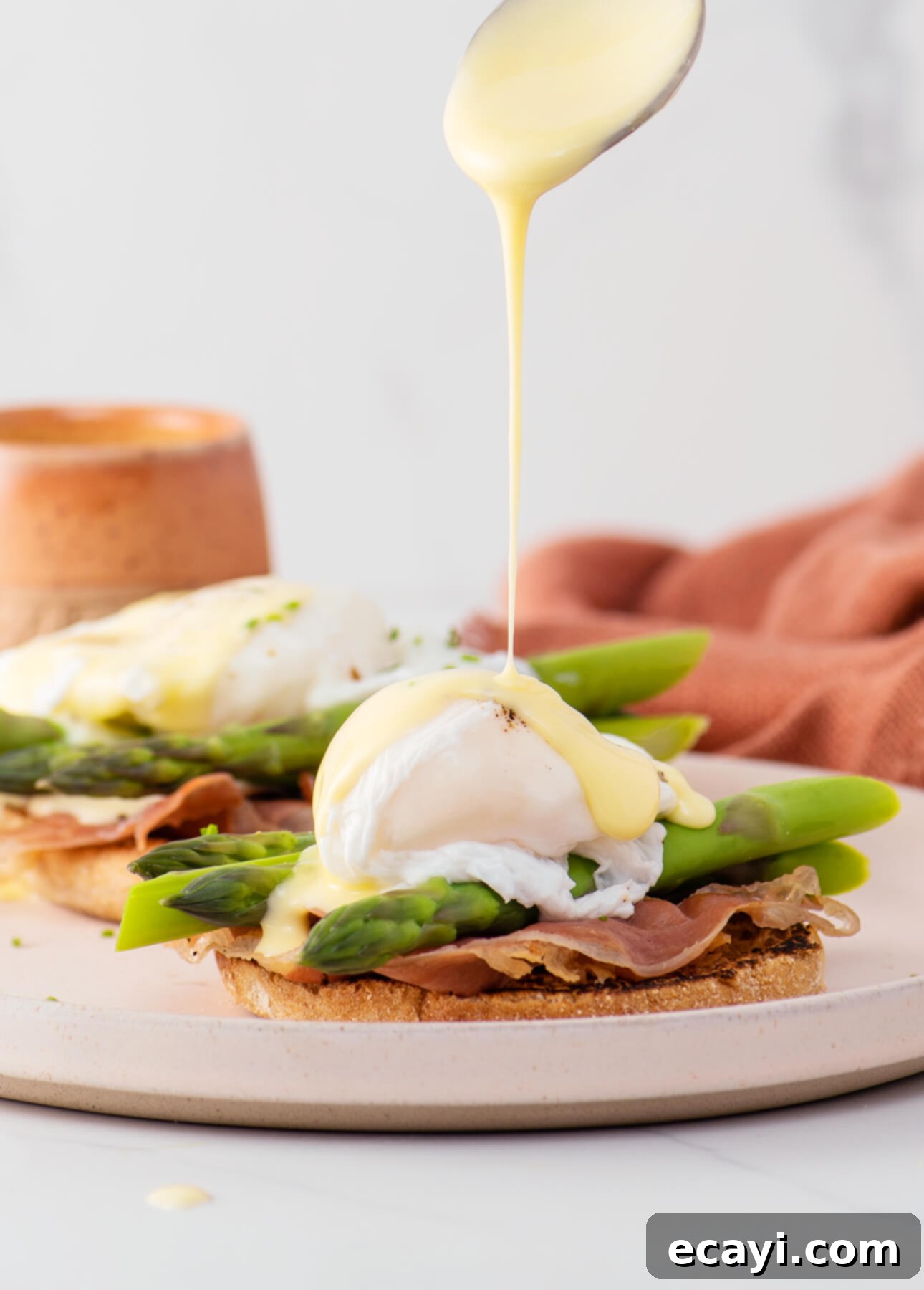Foolproof Homemade Eggs Benedict: Easy Blender Hollandaise & Perfect Poached Eggs Every Time
This comprehensive guide to foolproof Eggs Benedict empowers you to effortlessly recreate the beloved brunch classic at home, featuring an incredibly easy blender hollandaise sauce and expert tips for perfectly poached eggs. Say goodbye to kitchen intimidation and hello to restaurant-quality brunch!
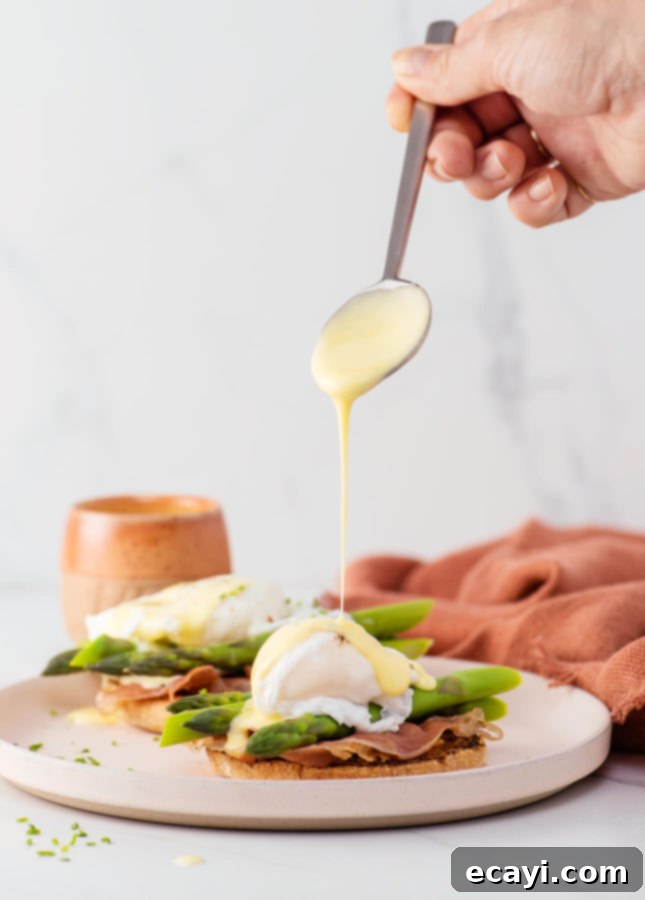
This post contains affiliate links. Full disclosure is at the bottom of the article.
Eggs Benedict stands proudly as a timeless breakfast and brunch classic, often gracing menus alongside other favorites like crêpes, croissants, and pancakes. Its popularity is undeniable, and for good reason: the harmonious blend of rich, runny eggs, a luxurious, tangy hollandaise sauce, savory ham (or other protein), and a perfectly toasted English muffin creates an unforgettable culinary experience. Indeed, Eggs Benedict offers everything you need to awaken your palate and kickstart your day on an exquisitely delicious note. It truly deserves a place in the breakfast hall of fame!
Despite its widespread appeal, preparing Eggs Benedict at home often feels like a daunting task. The primary source of this apprehension is almost always the hollandaise sauce. Revered as one of the five “mother sauces” of French cuisine, hollandaise is traditionally made by emulsifying egg yolks, melted butter, and lemon juice. This emulsion, a delicate blend of ingredients that typically resist mixing, is precisely what gives hollandaise its characteristic silky texture and rich flavor.
The “finicky” reputation of hollandaise sauce stems from the precise technique required to achieve this perfect emulsion. If the hot, melted butter is added too quickly or at an improper temperature, the egg yolks can “cook” and curdle, causing the sauce to separate or become grainy. This delicate balance between temperature and incorporation is what often intimidates home cooks, leading many to shy away from attempting this gourmet brunch dish in their own kitchens.
Beyond the initial emulsification, another challenge with traditional hollandaise sauce is maintaining its ideal temperature and texture. Reheating hollandaise over too high a heat can easily cause the delicate egg yolks to overheat and curdle, ruining the sauce’s smooth consistency. The conventional wisdom suggests whipping up hollandaise just before serving, allowing you to pour it warm over your freshly assembled Eggs Benedict. However, this last-minute preparation can be incredibly stressful, especially if you’re hosting guests or have never made the sauce from scratch before.
Fortunately, these common concerns are precisely what my foolproof Eggs Benedict recipe addresses. I’ve developed a method that simplifies both the hollandaise sauce preparation and the overall assembly process, removing the stress and making this elegant dish accessible to everyone. My secret lies in two key innovations: an unbelievably easy blender hollandaise sauce that comes together in mere seconds, and a strategic approach to timing that ensures all components are ready at the perfect moment. I’ll also share invaluable tips for properly reheating the sauce, proving that you can even make your hollandaise in advance without compromising quality. Imagine the luxury of preparing a gourmet brunch without a single bead of sweat!
Furthermore, this guide will walk you step-by-step through creating perfectly poached eggs, offering alternative cooking methods for those who prefer not to poach. I’ll teach you how to efficiently prepare all the individual elements of Eggs Benedict, enabling you to assemble this stunning dish with grace and confidence right in front of your appreciative guests. By adopting these techniques and embracing my foolproof recipe, you’ll not only master homemade Eggs Benedict but also discover a dangerously delicious habit. Be warned: once you experience the sheer delight of a homemade Eggs Benedict, you’ll likely want to make it a cherished weekend tradition!
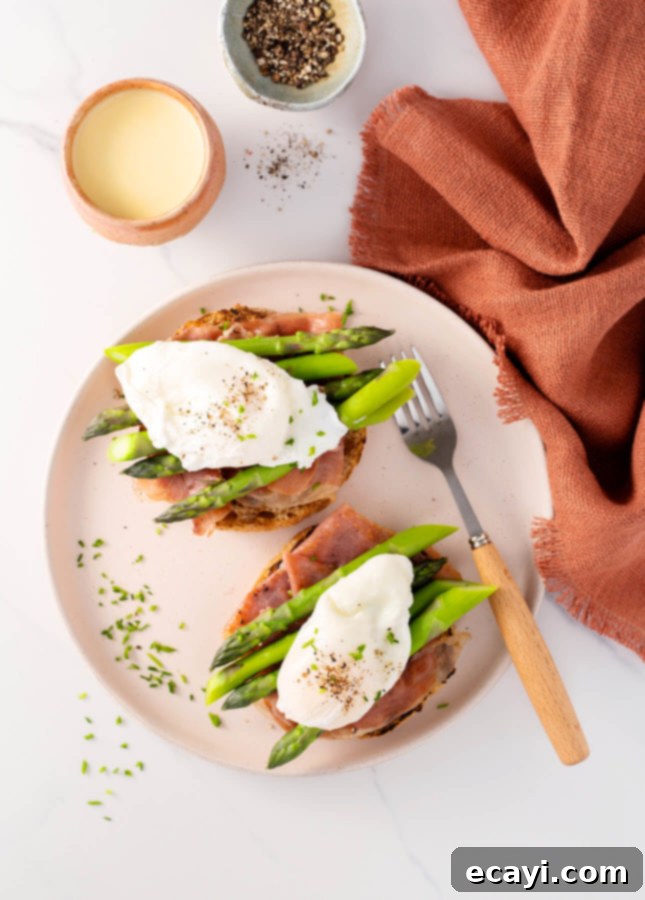
My Secret for Perfect, Foolproof Homemade Eggs Benedict
The cornerstone of a stress-free Eggs Benedict experience is strategic timing. My ultimate secret is simple: **prepare all the components and poach the eggs before you make the hollandaise sauce.** This approach ensures everything else is warm and ready when the hollandaise, which comes together in mere seconds using the blender method, is at its freshest and most perfect. This crucial timing allows you to serve the sauce immediately, piping hot and silky smooth, completely avoiding the need to reheat it. Since hollandaise is notoriously sensitive to heat, attempting to reheat it in a rush often leads to the dreaded splitting or breaking. While it *is* possible to safely reheat hollandaise sauce (and I’ll provide tips for that below), making it last eliminates this risk entirely, guaranteeing a flawless brunch experience every time.
How to Poach Perfectly Runny Eggs
Poaching eggs can seem intimidating, but with a few simple steps, you’ll achieve beautifully runny yolks and tender whites. Begin by bringing a large saucepan of water to a very gentle simmer. Look for tiny, consistent bubbles rising to the surface, but **the water absolutely should not be at a strong, rolling boil.** This gentle heat is key to preventing the eggs from breaking apart or cooking too rapidly. Throughout the poaching process, keep a close eye on the water temperature and adjust your heat as needed to maintain this delicate simmer. Stir in a generous pinch of salt and a tablespoon of vinegar; the vinegar helps the egg whites set quickly and maintain their shape, while the salt enhances flavor.
Crack **one egg** into a small bowl or ramekin. This step is important: it allows you to gently slide the egg into the water without splashing, and it also ensures no bits of shell end up in your delicate poached egg. Make certain the yolk remains intact, as a broken yolk won’t poach properly. Gently tip the bowl and carefully slide the entire egg into the simmering water. Quickly repeat this process for the remaining 3 eggs, adding them one by one. Cooking time is critical for your desired yolk consistency: aim for approximately 3½ minutes for a beautifully runny yolk, or extend to 4½ minutes for a slightly more set, “jammy” yolk. Once cooked, use a slotted spoon to carefully lift each egg out of the water, allowing any excess water to drain. Transfer them to a small plate, then place this plate over the warm serving plates in the oven to keep them perfectly warm until you’re ready to assemble your Eggs Benedict.
Substituting Poached Eggs in Eggs Benedict
While classic Eggs Benedict typically features poached eggs, there are many reasons why you might prefer an alternative, whether it’s personal preference, time constraints, or a simple desire for variety. The good news is that this iconic dish is incredibly versatile! **Here are some fantastic substitution ideas for poached eggs in your homemade Eggs Benedict, ensuring everyone at your table can enjoy this brunch delight:**
- Fried Eggs: For a quick and easy alternative, fried eggs are an excellent choice. Heat a non-stick skillet over medium-high heat with a drizzle of oil or a pat of butter. Crack your eggs directly onto the hot surface, season with salt and pepper, and cook until the whites are fully set but the yolks are still wonderfully runny. Transfer them to a plate and keep warm in a low oven (around 150°F / 65°C) until serving.
- Over-Easy Eggs: Building on the fried egg method, over-easy eggs offer a slightly firmer white with a still-runny yolk. Follow the directions for fried eggs, but just as the whites are nearly set, carefully use a spatula to flip each egg. Cook for an additional 30 seconds to 1 minute, depending on how set you like your yolks. The key is a quick flip to gently cook the top without solidifying the center. Remove to a plate and keep warm in a low oven.
- Scrambled Eggs: Some people simply aren’t fans of runny yolks, and that’s perfectly fine! They shouldn’t miss out on Eggs Benedict. For a scrambled version, crack eggs into a bowl, whisk well with a splash of milk or cream if desired, and season with salt and pepper. Pour into a hot, greased non-stick skillet and cook, stirring gently with a spatula, until the eggs are cooked through but still appear moist and fluffy. Remember, they’ll continue to cook slightly from residual heat, so err on the side of slightly undercooked for optimal texture.
- Soft- or Hard-Boiled Eggs: These can be prepared entirely in advance, making for even quicker assembly. Place eggs in a saucepan and cover with water by about an inch (2.5 cm). Add a teaspoon of salt, bring to a vigorous boil over high heat, then immediately remove from the heat, cover, and let rest. For soft-boiled eggs with a jammy yolk, allow 6 to 7 minutes. For fully set, hard-boiled eggs, wait 11 minutes. Drain, rinse under cold water, and transfer to an ice bath to cool completely. Once chilled, peel, slice in half, and they’re ready to be incorporated into your Eggs Benedict.
- Skip the Eggs Completely: While it might sound unconventional to make “Eggs” Benedict without the eggs, culinary creativity knows no bounds! For a delicious vegetarian option, you can pan-fry thick, seasoned slices of extra-firm tofu until golden brown and crispy. Alternatively, use extra slices of your chosen meat, like ham or smoked salmon, to make a “Benedict Royale” without the eggs. Explore the “More Serving Ideas” section below for even further inspiration on customizing your perfect Eggs Benedict.
How to Make Blender Hollandaise Sauce
This blender method is the ultimate game-changer for homemade hollandaise, making it incredibly easy and virtually foolproof! You’ll achieve a perfect sauce in mere seconds, without the need for a double boiler or constant whisking. To start, combine the egg yolks, warm water, fresh lemon juice, and a pinch of salt in the container of a stand blender. Secure the lid and blend on high speed until the mixture is frothy and pale yellow. While that’s blending, melt the butter. You can do this quickly in the microwave or in a small saucepan over medium heat until it’s bubbly and hot, but be careful not to brown it. Once the butter is melted and hot, turn the blender back on to a low setting. With the blender running continuously, **slowly and steadily pour the hot melted butter in a very thin stream into the egg yolk mixture.** This gradual addition is key to forming the emulsion. Continue blending until the sauce visibly thickens and becomes smooth and emulsified. Voilà! Your perfect blender hollandaise is ready.
If you don’t have a stand blender, you can achieve similar results using a hand mixer (also known as an immersion blender). Simply combine the ingredients in the hand mixer’s tall blending cup, or in a large measuring cup, following the same order and technique described above for adding the hot butter. The principle remains the same: steady blending and a slow, thin stream of hot butter for a perfect emulsion.
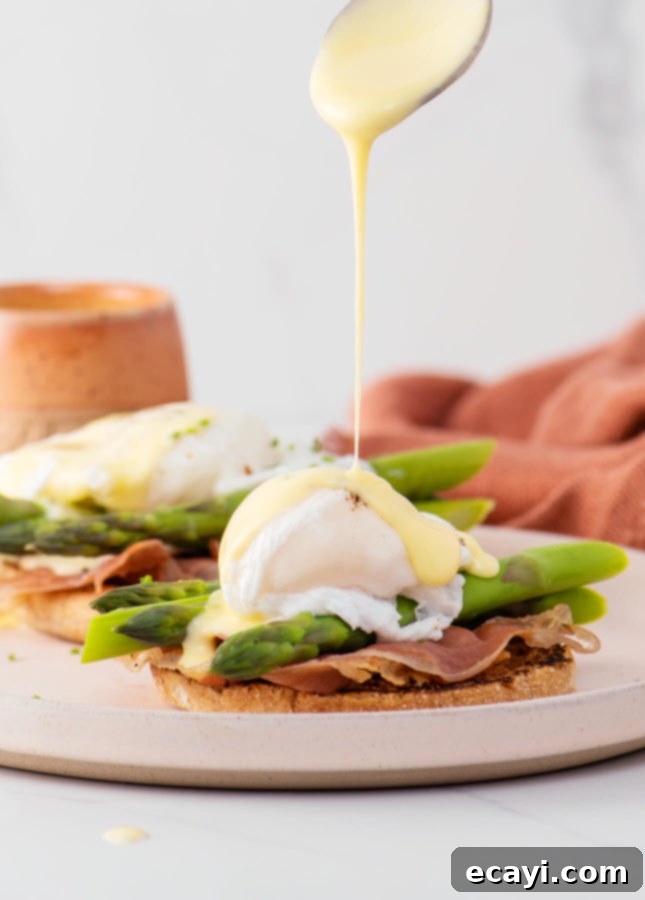
How to Fix Split or Curdled Hollandaise Sauce
Even with the foolproof blender method, sometimes things can go awry. It’s important to understand the difference between a split sauce and a curdled one, as they require different solutions (or lack thereof!). **Hollandaise sauce “splits” when the fat (butter) separates from the rest of the liquid ingredients, indicating that the emulsion has broken.** This often results in a greasy, watery consistency. **Hollandaise sauce “curdles” when it has been overheated, causing the delicate egg yolks to cook and solidify, leading to a grainy or chunky texture.**
Here’s how to fix a split Hollandaise sauce (don’t panic!): The good news is that a split sauce can almost always be rescued. The easiest method involves adding another egg yolk. In a small, separate bowl, whisk together 1 fresh egg yolk with 1 tablespoon of cold water. Turn your blender back on to a low speed. With the blender running, slowly pour this egg yolk and water mixture into your split hollandaise sauce. Blend for another 10-15 seconds; the sauce should miraculously come back together, smooth and emulsified once more. If you don’t have an extra egg yolk on hand, you can try whisking in 1 to 2 tablespoons (15 to 30 ml) of very hot water or heavy cream, adding it slowly until the sauce re-emulsifies.
Unfortunately, **you cannot fix curdled hollandaise sauce.** Once the egg yolks have cooked and become grainy or lumpy due to excessive heat, there’s no way to reverse this process. The texture is irreversibly damaged. While disheartening, the best course of action is to accept the loss and start the sauce from scratch. This is another reason why gentle heat and the blender method are so highly recommended!
How to Reheat Hollandaise Sauce
As we’ve discussed, hollandaise sauce is incredibly sensitive to heat, which means reheating it requires extreme care and a very gentle approach. The ideal method for reheating hollandaise sauce is using a double-boiler. Place the sauce in the top bowl of a double-boiler setup, ensuring the bottom pot contains about 1 inch (2.5 cm) of water that is simmering gently (not boiling vigorously). Whisk the hollandaise constantly and gently until it is warmed through. This indirect heat ensures the egg yolks won’t cook further.
**I strongly advise against reheating hollandaise sauce in the microwave.** Microwave ovens vary widely in power, and even a few seconds too long can easily overheat and curdle your delicate sauce, forcing you to discard it and start over. The risk simply isn’t worth it when dealing with such a heat-sensitive emulsion.
If you don’t own a double-boiler, you can create a makeshift version: simply bring a small saucepan of water to a simmer, then place a larger stainless steel mixing bowl securely over the saucepan, ensuring the bottom of the bowl does not touch the simmering water. Add your hollandaise to the bowl and whisk continuously until it reaches the desired warm temperature.
It’s also worth noting that hollandaise sauce does not need to be boiling hot when served—in fact, simply warm is often sufficient. If all the other components of your Eggs Benedict (like the toasted muffins, hot protein, and freshly poached eggs) are already hot, the sauce will be further warmed upon contact, resulting in a dish served at a perfect, harmonious temperature. **If, despite your best efforts, your hollandaise sauce splits or appears to curdle during the reheating process,** refer to my troubleshooting tips above to attempt to bring it back together before giving up!
More Serving Ideas for Eggs Benedict
While my personal favorite way to enjoy foolproof Eggs Benedict is on toasted whole wheat English muffin halves with crispy prosciutto and tender steamed asparagus, the beauty of this dish lies in its incredible adaptability. Eggs Benedict is a canvas for culinary creativity, allowing you to customize it with a wide array of ingredients to suit any taste or dietary preference. Don’t be afraid to experiment and make it your own!
Here are some inspiring serving ideas to elevate your homemade Eggs Benedict:
- Replace the asparagus with: Get creative with your greens! Consider steamed or sautéed spinach, Swiss chard, or kale for a nutrient-rich addition. Sliced avocado adds a creamy texture and healthy fats, while oven-roasted cherry tomatoes provide a burst of sweet acidity. Sautéed mushrooms, especially cremini or shiitake, lend an earthy, umami depth.
- Replace the prosciutto with: The protein component is incredibly versatile. Traditional options include classic ham or Canadian bacon. For a luxurious twist, try cold- or hot-smoked salmon to create a “Smoked Salmon Benedict,” or opt for rich steamed lobster or crab meat for a truly indulgent experience. Sliced grilled chicken, flavorful sautéed fresh sausage, or crispy bacon also make excellent choices, offering different textures and flavor profiles.
- Replace the English muffin with: The base doesn’t have to be limited to English muffins! Toasted slices of crusty artisan bread (sourdough is a fantastic choice), elegant toasted baguette slices, or rich, buttery toasted brioche can elevate the experience. For a fun twist, plain waffles (ensure they are savory waffles, perhaps with cheese and herbs, not sweet!) or homemade buttermilk biscuits provide unique textures and flavors.
- Garnish with: The right garnish can add both visual appeal and an extra layer of flavor. Fresh herbs like finely minced chives or parsley are always a good choice. Shaved Parmigiano-Reggiano adds a salty, nutty bite, while a sprinkle of crushed red pepper flakes introduces a subtle warmth. Chopped capers provide a briny tang, and a drizzle of homemade pesto or romesco sauce can completely transform the flavor profile.
Remember, there’s no single “wrong” way to serve my foolproof Eggs Benedict. Let your culinary imagination guide you and bon appétit!
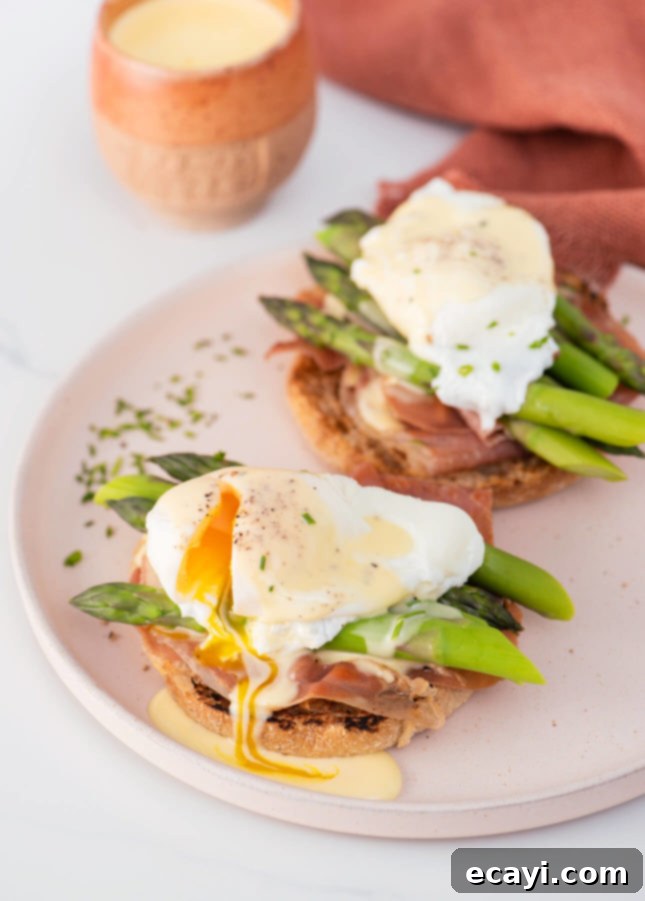
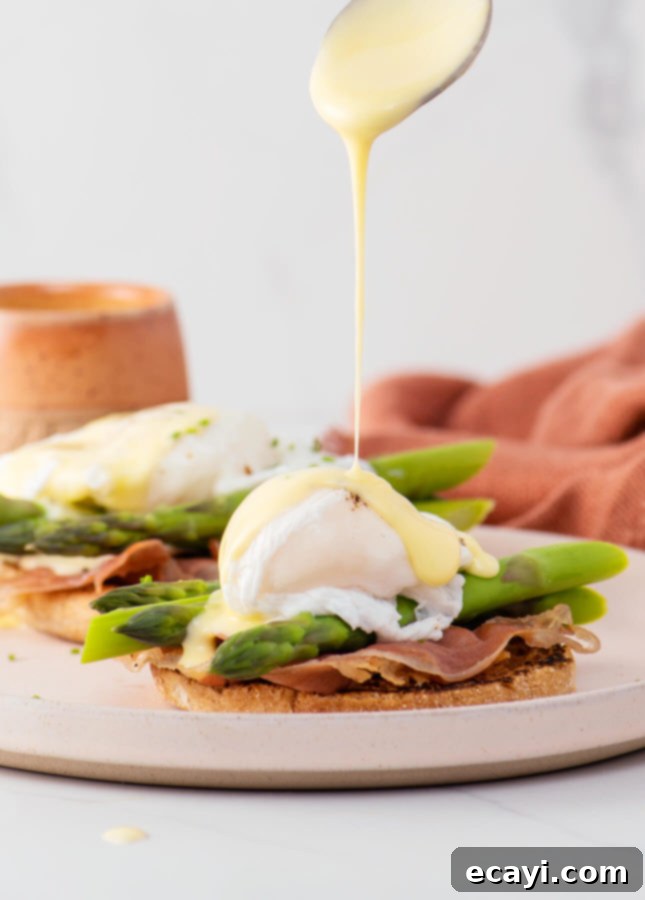
Pin Recipe
Foolproof Eggs Benedict with Blender Hollandaise Sauce
Ingredients
To assemble the eggs benedict
- 8 thick asparagus stalks, tough ends removed and split lengthwise (or 16 thin asparagus stalks)
- 4 slices prosciutto, pancetta, or ham
- 2 English muffins, split
For the poached eggs
- 4 large eggs
- 1 tbsp kosher salt or fine sea salt
- 1 tbsp white vinegar
For the blender hollandaise sauce
- 2 large egg yolks
- 1 tbsp warm water
- 1 tbsp fresh lemon juice
- 1/2 tsp kosher salt or fine sea salt
- 1/2 cup unsalted butter (1 stick)
To serve
- Minced chives (optional)
- Freshly ground black pepper
Instructions
-
Here’s my foolproof secret to successful eggs benedict: Prepare all the components and poach the eggs before you make the sauce.
The sauce should be the last thing you make because it comes together in seconds. Doing so will allow you to serve the sauce hot and avoid having to reheat it. Since hollandaise sauce is so sensitive to heat, reheating it means you risk splitting or breaking it. It is possible to safely reheat hollandaise sauce though; see notes at the end of the recipe.
Prepare the assembly ingredients:
-
Preheat the oven to 300°F (150°C). Line a baking sheet with parchment paper and place it in the oven. Stack two serving plates on one side of the baking sheet to warm them up.
-
Fill a large bowl with ice water. Bring a saucepan of salted water to a boil, then add the asparagus and blanch for 1 minute. Transfer the asparagus to the ice water to stop the cooking and cool. Remove and pat dry. Place on the baking sheet in the oven.
-
If using prosciutto or pancetta, set a non-stick skillet over medium-high heat. Add the slices of prosciutto or pancetta and cook about 30 seconds per side, or until lightly browned and crisp. Transfer to the baking sheet in the oven.
If using ham, simply place it on the baking sheet in the oven.
-
Toast the English muffins and transfer them to the baking sheet in the oven.
Make the poached eggs:
-
Bring a large saucepan of water to a gentle simmer. You should see tiny bubbles coming to the surface of the water, but the water should not come to a strong, rolling boil.
Adjust the temperature throughout the cooking process to keep the water very hot but not boiling.
Mix in the salt and vinegar.
-
Crack one egg in a small bowl (make sure not to break the yolk or you won’t be able to poach it) then gently slide the entire egg into the water. Quickly repeat the process to add all 4 eggs to the hot water. (Breaking the eggs in a small bowl before sliding them in the water creates rounder poached eggs and ensures no broken shell gets in.) Cook the eggs for 3½ minutes for a runny yolk, or for up to 4½ minutes for a slightly set, jammy yolk.
-
Use a slotted spoon to fish the eggs out one by one and set them on a small plate. Transfer this small plate over the warm serving plates in the oven to keep warm.
Make the blender hollandaise sauce:
-
In a stand blender, combine the egg yolks, water, lemon juice, and salt; blend until frothy. (You can also do this using a hand mixer—simply mix the ingredients in the mixer’s cup, or in a tall measuring cup.) Melt the butter in the microwave or in a small saucepan over medium heat until bubbly (do not brown). With the blender running, pour in the hot butter in a very thin stream, blending until sauce is thick and emulsified.
What to do if your blender hollandaise sauce breaks
-
(i.e. If the fat separates from the rest of the sauce or it starts to look curdled)
Adding one egg yolk to the sauce will bring it back together! Here’s how to do it: in a small bowl, whisk together 1 egg yolk and 1 tablespoon cold water. Turn the blender back on at low speed. With the blender running, slowly pour the egg yolk/water mixture into the sauce. Mix for 10-15 seconds and the sauce should be fixed.
Immediately assemble the eggs benedict:
-
Take the baking sheet with all your prepped ingredients and the warm plates out of the oven. Set the serving plates side by side on a working surface. Over each plate, set two English muffin halves, cut side up. Spread one spoonful of blender hollandaise sauce over each muffin half, cover with the slices of prosciutto, pancetta, or ham, then divide the asparagus stalks over the meat. Top with the poached eggs and generously cover with hollandaise sauce. Garnish with chives and freshly ground black pepper and serve right away.
Notes
Hollandaise sauce is a sauce that can split easily. If you need to reheat hollandaise sauce, you need to do so using very gentle heat. You can either reheat it in a double-boiler while whisking constantly (make sure the water is simmering, not boiling hard) or in the microwave by 5-second bursts at low power, whisking between each burst.
Hollandaise sauce does not need to be piping hot when serving—in fact, warm is enough. If all the other components of the dish are hot, the sauce will be warmed upon touching them and the resulting dish will be served at a perfect temperature. If the hollandaise sauce splits during the reheating process, see the tip in the recipe above to bring it back together.
Did you make this?
Tell me how you liked it! Leave a comment or take a picture and tag it with @foodnouveau on Instagram.
This site is a participant in the Amazon Associates Program, an affiliate advertising program designed to provide a means for the site to earn fees by linking to Amazon and affiliated sites.
If you click on an affiliate link, I may earn advertising or referral fees if you make a purchase through such links, at no extra cost to you. This helps me creating new content for the blog–so thank you! Learn more about advertising on this site by reading my Disclosure Policy.
